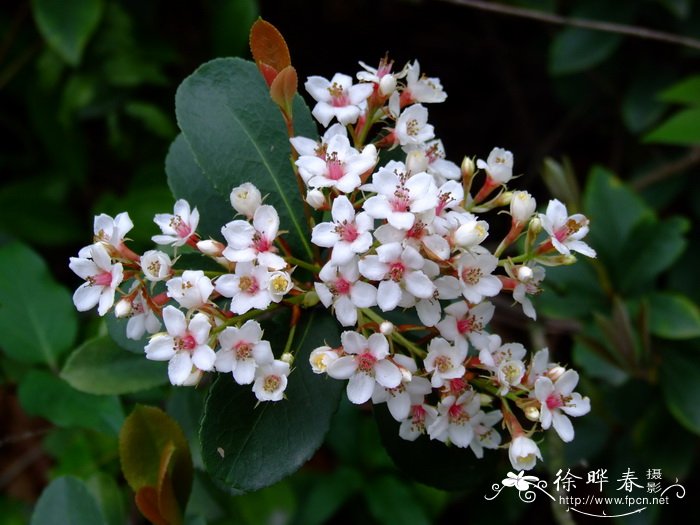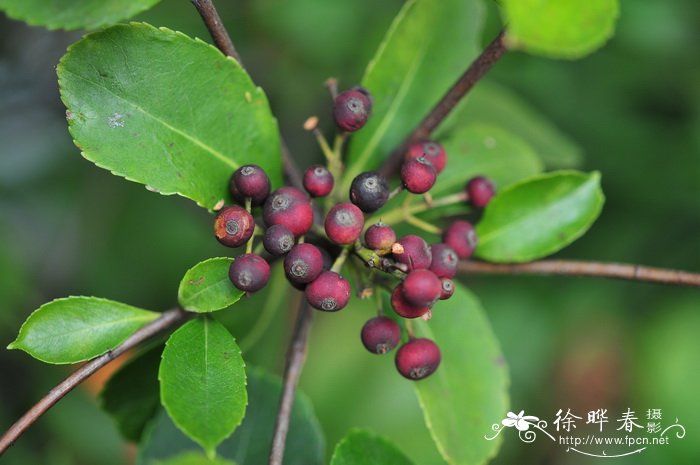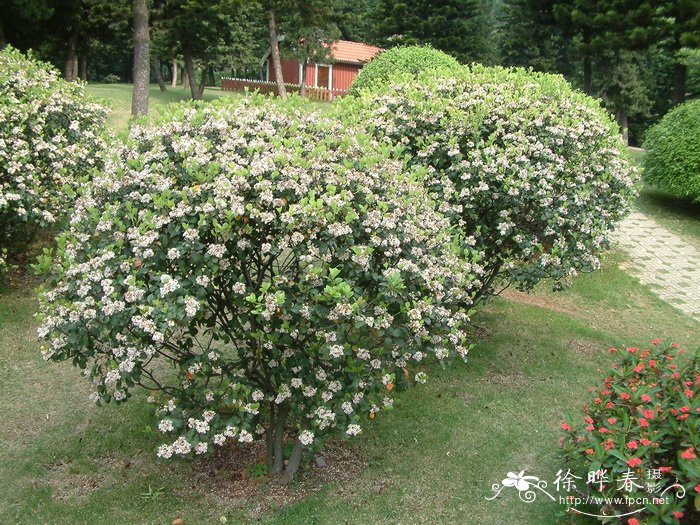石斑木Rhaphiolepis indica
中文名(Chinese Name):石斑木
学名(Scientific Name):Rhaphiolepis indica (L.) Lindl.
英文名(English Common Name):
别名(Chinese Common Name):春花、车轮梅
异名(Synonym):Raphiolepis indica (Linn.) Lindl. Crataegus rubra Lour. Mespilus sinensis Poir. Rhaphiolepis rubra (Lour.) Lindl. Rhaphiolepis rugosa Nakai Rhaphiolepis sinensis M. Roem. Rhaphiolepis parvibracteolata Merr. Rhaphiolepis gracilis Nakai Crataegus indica L. Eriobotrya metrosideros A.Chev. Opa metrosideros Lour. Rhaphiolepis loureiri Spreng. Rhaphiolepis indica var. typica Nakai
科属(Family & Genus):蔷薇科(Rosaceae)石斑木属
形态特征(Description):常绿灌木,稀小乔木,高可达4米;幼枝初被褐色绒毛,以后逐渐脱落近于无毛。叶片集生于枝顶,卵形、长圆形,稀倒卵形或长圆披针形,长 (2-) 4-8厘米,宽1.5-4厘米,先端圆钝,急尖、渐尖或长尾尖,基部渐狭连于叶柄,边缘具细钝锯齿,上面光亮,平滑无毛,网脉不显明或显明下陷,下面色淡,无毛或被稀疏绒毛,叶脉稍凸起,网脉明显;叶柄长5-18毫米,近于无毛;托叶钻形,长3-4毫米,脱落。顶生圆锥花序或总状花序,总花梗和花梗被锈色绒毛,花梗长5-15毫米;苞片及小苞片狭披针形,长2-7毫米,近无毛;花直径1-1.3厘米;萼筒筒状,长4-5毫米,边缘及内外面有褐色绒毛,或无毛;萼片5,三角披针形至线形,长4.5-6毫米,先端急尖,两面被疏绒毛或无毛;花瓣5,白色或淡红色,倒卵形或披针形,长5-7毫米,宽4-5毫米,先端圆钝,基部具柔毛;雄蕊15,与花瓣等长或稍长;花柱2-3,基部合生,近无毛。果实球形,紫黑色,直径约5毫米,果梗短粗,长5-10毫米。花期4月,果期7-8月。
分布(Distribution):产安徽、浙江、江西、湖南、贵州、云南、福建、广东、广西、台湾,生于海拔150-1600米山坡、路边或溪边灌木林中。日本、老挝、越南、柬埔寨、泰国和印度尼西亚也有。
用途(Use):木材带红色,质重坚韧,可作器物;果实可食。
引自中国植物志英文版:FOC Vol. 9 Page 142
Rhaphiolepis indica (Linnaeus) Lindley, Bot. Reg. 6: t. 468. 1820.
石斑木 shi ban mu| Rosaceae | Rhaphiolepis
Shrubs, rarely small trees, to 4 m tall. Branchlets purplish brown when young, grayish brown when old, terete, initially brown tomentose, glabrous when old. Petiole 0.5–1.8 cm or nearly absent, slightly brown tomentose or, subglabrous; stipules caducous, lanceolate, sparsely brown tomentose, apex acuminate; leaf blade ovate, oblong, rarely obovate, oblong-lanceolate, narrowly elliptic or lanceolate-elliptic, (2–)4–8 × 1.5–4 cm, leathery, veins prominent abaxially, reticulate veins conspicuous abaxially and conspicuous or not adaxially, abaxially pale, glabrous or sparsely tomentose, adaxially lustrous, glabrous, base attenuate, margin crenulate, serrate, or obtusely serrate, apex obtuse, acute, acuminate, or long caudate. Panicle or racemes terminal, many- or few flowered; peduncle and pedicels rusty tomentose; bracts and bractlets caducous, lanceolate or narrowly lanceolate, 2–7 mm, both surfaces initially brown tomentose, densely so at margin, soon glabrescent, apex acuminate. Pedicel 0.5–1.5 cm, initially brown tomentose, soon glabrescent. Flowers 1–1.3(–1.5) cm in diam. Hypanthium tubular, brown tomentose at margin and on both surfaces or glabrous. Sepals triangular-lanceolate or linear, 4.5–6 mm, both surfaces slightly brown tomentose or glabrous, apex acute. Petals white or pinkish, obovate or lanceolate, 5–7 × 4–5 mm, pubescent basally, apex obtuse. Stamens 15, ca. as long as or shorter than petals. Ovary glabrous, 2- or 3-loculed, with 2 ovules per locule; styles 2 or 3, connate at base, subglabrous. Pome purplish black, globose, 5–8 mm in diam., glabrous; fruiting pedicel 5–10 mm, glabrous; sepals caducous, leaving an annular ring. Fl. Apr, fr. Jul–Aug.
Slopes, roadsides, thickets at stream sides; 700--1600 m. Anhui, Fujian, Guangdong, Guangxi, Guizhou, Hainan, Hunan, Jiangxi, Taiwan, Yunnan, Zhejiang [Cambodia, Japan, Laos, Thailand, Vietnam].



(责任编辑:徐晔春)
学名(Scientific Name):Rhaphiolepis indica (L.) Lindl.
英文名(English Common Name):
别名(Chinese Common Name):春花、车轮梅
异名(Synonym):Raphiolepis indica (Linn.) Lindl. Crataegus rubra Lour. Mespilus sinensis Poir. Rhaphiolepis rubra (Lour.) Lindl. Rhaphiolepis rugosa Nakai Rhaphiolepis sinensis M. Roem. Rhaphiolepis parvibracteolata Merr. Rhaphiolepis gracilis Nakai Crataegus indica L. Eriobotrya metrosideros A.Chev. Opa metrosideros Lour. Rhaphiolepis loureiri Spreng. Rhaphiolepis indica var. typica Nakai
科属(Family & Genus):蔷薇科(Rosaceae)石斑木属
形态特征(Description):常绿灌木,稀小乔木,高可达4米;幼枝初被褐色绒毛,以后逐渐脱落近于无毛。叶片集生于枝顶,卵形、长圆形,稀倒卵形或长圆披针形,长 (2-) 4-8厘米,宽1.5-4厘米,先端圆钝,急尖、渐尖或长尾尖,基部渐狭连于叶柄,边缘具细钝锯齿,上面光亮,平滑无毛,网脉不显明或显明下陷,下面色淡,无毛或被稀疏绒毛,叶脉稍凸起,网脉明显;叶柄长5-18毫米,近于无毛;托叶钻形,长3-4毫米,脱落。顶生圆锥花序或总状花序,总花梗和花梗被锈色绒毛,花梗长5-15毫米;苞片及小苞片狭披针形,长2-7毫米,近无毛;花直径1-1.3厘米;萼筒筒状,长4-5毫米,边缘及内外面有褐色绒毛,或无毛;萼片5,三角披针形至线形,长4.5-6毫米,先端急尖,两面被疏绒毛或无毛;花瓣5,白色或淡红色,倒卵形或披针形,长5-7毫米,宽4-5毫米,先端圆钝,基部具柔毛;雄蕊15,与花瓣等长或稍长;花柱2-3,基部合生,近无毛。果实球形,紫黑色,直径约5毫米,果梗短粗,长5-10毫米。花期4月,果期7-8月。
分布(Distribution):产安徽、浙江、江西、湖南、贵州、云南、福建、广东、广西、台湾,生于海拔150-1600米山坡、路边或溪边灌木林中。日本、老挝、越南、柬埔寨、泰国和印度尼西亚也有。
用途(Use):木材带红色,质重坚韧,可作器物;果实可食。
引自中国植物志英文版:FOC Vol. 9 Page 142
Rhaphiolepis indica (Linnaeus) Lindley, Bot. Reg. 6: t. 468. 1820.
石斑木 shi ban mu| Rosaceae | Rhaphiolepis
Shrubs, rarely small trees, to 4 m tall. Branchlets purplish brown when young, grayish brown when old, terete, initially brown tomentose, glabrous when old. Petiole 0.5–1.8 cm or nearly absent, slightly brown tomentose or, subglabrous; stipules caducous, lanceolate, sparsely brown tomentose, apex acuminate; leaf blade ovate, oblong, rarely obovate, oblong-lanceolate, narrowly elliptic or lanceolate-elliptic, (2–)4–8 × 1.5–4 cm, leathery, veins prominent abaxially, reticulate veins conspicuous abaxially and conspicuous or not adaxially, abaxially pale, glabrous or sparsely tomentose, adaxially lustrous, glabrous, base attenuate, margin crenulate, serrate, or obtusely serrate, apex obtuse, acute, acuminate, or long caudate. Panicle or racemes terminal, many- or few flowered; peduncle and pedicels rusty tomentose; bracts and bractlets caducous, lanceolate or narrowly lanceolate, 2–7 mm, both surfaces initially brown tomentose, densely so at margin, soon glabrescent, apex acuminate. Pedicel 0.5–1.5 cm, initially brown tomentose, soon glabrescent. Flowers 1–1.3(–1.5) cm in diam. Hypanthium tubular, brown tomentose at margin and on both surfaces or glabrous. Sepals triangular-lanceolate or linear, 4.5–6 mm, both surfaces slightly brown tomentose or glabrous, apex acute. Petals white or pinkish, obovate or lanceolate, 5–7 × 4–5 mm, pubescent basally, apex obtuse. Stamens 15, ca. as long as or shorter than petals. Ovary glabrous, 2- or 3-loculed, with 2 ovules per locule; styles 2 or 3, connate at base, subglabrous. Pome purplish black, globose, 5–8 mm in diam., glabrous; fruiting pedicel 5–10 mm, glabrous; sepals caducous, leaving an annular ring. Fl. Apr, fr. Jul–Aug.
Slopes, roadsides, thickets at stream sides; 700--1600 m. Anhui, Fujian, Guangdong, Guangxi, Guizhou, Hainan, Hunan, Jiangxi, Taiwan, Yunnan, Zhejiang [Cambodia, Japan, Laos, Thailand, Vietnam].
(责任编辑:徐晔春)
踩一下[0]

顶一下[1]